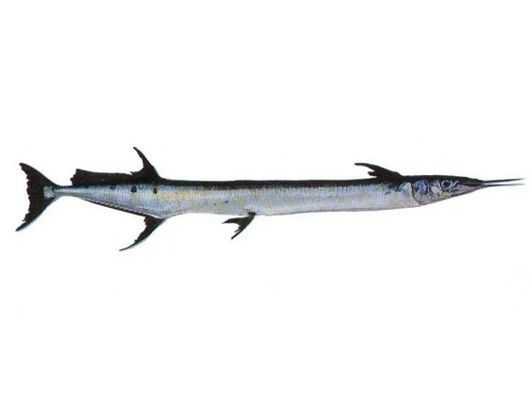Flat Needlefish

Species Details
Ablennes Hians
Belonidae
Beloniformes
Inshore, Offshore
7 - 11 lbs.
40" - 55"
Flat Needlefish (Ablennes hians) Fish Description
Also known as the Giant Needlefish, Stickfish, Longtoms, Houndfish, Grassfish, Garfish, Gaping Needlefish, Full Beak, Flat-sided Needlefish, Flat Billfish, Eel Pike, Barred Longtom, and the Barred Needlefish, the Flat Needlefish is the only member under the Ablennes genus. The body of a flat needlefish is elongated; it is dark bluish above, and silvery white underneath.
Flat Needlefish do not possess any spines nor gill rakers, but they have numerous soft rays: 24 to 28 on the anal fins, and 23 to 26 on the dorsal fin. They have around 86 to 93 vertebrae. Their anal and pectoral fins are shaped like a scythe.
The dorsal part of the Flat Needlefish has a blue hue, whereas its center has 12 to 14 vertical bars and several dark blotches. The dorsal fins contain a dark lobe underneath, and around 470 to 525 scales.
The jaws of the Flat Needlefish look like a short beak graced with several thin, needle- like teeth.
Diet and Size
Flat Needlefish feed on small fishes by catching them using their long beaks, then swallowing their prey head first. In return, they are preyed upon by dolphins and larger fishes.
On average, Flat Needlefish can measure up to 47 inches, and weigh 11 pounds.
Interesting Facts About the Flat Needlefish
- The Flat Needlefish’s genus name Ablennes used to be misspelled as Athlennes; the former translates to ‘without mucosity’. Hians, on the other hand, is Latin that means ‘gaping’.
- The name of the Flat Needlefish is derived from its very thin and long arrow-like body which is due to its elongated jaw.
- When measuring the Flat Needlefish’s body, its head and caudal fins are not included since its long jaws are often cut off.
- Eggs of Flat Needlefish are attached to floating debris.
- Strangely, the right gonad of both male and female Flat Needlefish are non-existent most of the time. Only their left gonad is fully developed.
- Flat Needlefish are considered a pest in some areas and are not eaten because of their green-colored flesh and bones.
Fishing Techniques
For anglers, the Flat Needlefish is known as a gamefish (see other popular game fish: Blue Marlin, Atlantic Sailfish, Bluefin Tuna, Tarpon, Yellowfin). It can easily be captured using artificial lights as a lure.
Luckily for anglers, the Flat Needlefish is a species of least concern due to its stable population. They can be commercially fished all over the world using seines and lures, but they are not really consumed. They are either retained to be used as bait, or a “catch and release” kind of fish. If you wish to catch them using lures, make sure to reel them in as soon as you cast the lure.
If you are targeting the small ones, a treble hook can be used with small pieces of fish or squid as bait. Make sure that the bait does not remain motionless since Needlefish tend to pursue active baits. If you wish to capture big Needlefish, you can use a synthetic microfiber material to troll for them, entangling them so as to prevent them from escaping.
Habitat and Distribution
Flat needlefish can be found in waters globally, especially in temperate and tropical seas. They are specifically located in the Eastern Atlantic especially in Angola and Cape Verde, as well as in Massachusetts to Brazil. They are also common throughout the Indian Ocean, as well as from the Chesapeake Bay in Brazil in the Western Atlantic. They also thrive in Tuvalu, Australia, and Japan.
This species likes estuaries, waters near islands, and coastal rivers where they sometimes gather in big schools. The Flat Needlefish generally inhabit the pelagic and inshore areas.





